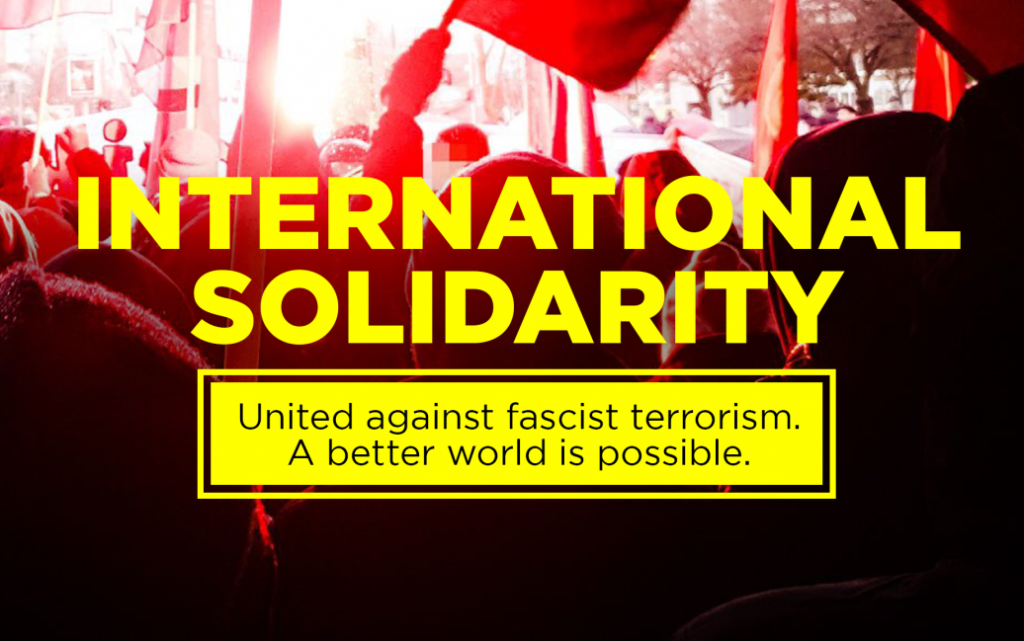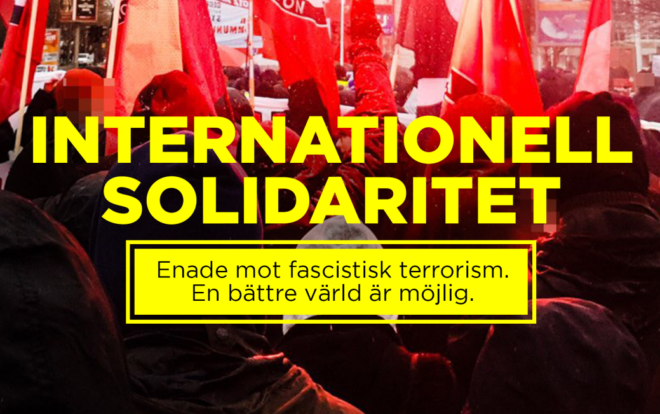De genomför sina planer med kirurgisk precision
Utan att ens beröras
Blod är för dem som medaljer;
slakten är en heroisk akt.
(Ur Victor Jaras sista dikt, 1973)
Det är med sorg och indignation som vi återigen mottar nyheten om ett fascistiskt terrordåd – denna gång från Nya Zeeland – som har slitit nära och anhöriga ur armarna på varandra.
Vi har sett det hända förr: i Quebec, i Pittsburgh, på Utøya, i Charleston – för att nämna endast några få exempel. Nyheterna om fascistiska massmord slår oss inte längre med förvåning – tvärtom så har de blivit en del av det förväntade. Dessa dåd har blivit något vi kan vänta oss, i en samtid av alltmer öppen rasism och fascistisk mobilisering i såväl politiken som på internet.
Denna potential till urskillningslöst våld är ingen ny tendens inom den moderna fascistiska miljön – vi har sett dem bomba, skjuta och mörda tidigare, i såväl Sverige som runtom i världen. Det vi nu ser hända handlar inte bara om våldet, utan också om de politiska reaktionerna och dynamiken som fascismen skapar gentemot den etablerade högern, och hur unga högerextremister radikaliseras via internet.
Vi ha sedan attentatet i Oslo och massmorden på Utøya kunnat studera hur en ny dynamik har utvecklats, där attentat och våldsdåd inte enbart ses som terroristiska dåd, utan i lika hög grad hanteras som möjligheter för marknadsföring av rasistisk politik. De mest utstuderade massmördarna planerar sina attentat många år i förhand. De förbereder manifest att skicka ut till olika medier, med noggranna paketeringar av hur dåden ska tolkas av omvärlden och vilka värdeord som tidningarna ska sprida i sina rapporteringar.
Det är lätt att tro att den här sortens terrordåd är till nackdel för fascismens sak. Våra erfarenheter av europeisk och nordisk politik talar emot en sådan tolkning. Vi har sedan de norska attentaten 2011 kunnat se hur Anders Behring Breiviks världsåskådning i allt större grad har spridit sig och cementerats som givna element i såväl nyfascistiska miljöer som i den etablerade politiken. Breiviks manifest introducerade en ny begreppsvärld i nordisk politik – och idag höjer ingen längre på ögonbrynen om en konservativ politiker pratar om hotet från ”kulturmarxisterna”, trots att det är samma ord som 2011 motiverade morden på 69 ungsocialister.
Genom processer av eko och ömsesidig bekräftelse har den nyfascistiska begreppsvärlden tagit plats i vardaglig politisk vokabulär. Från ljusskygga internetforum, till rasistiska nyhetsportaler och riksdagspolitiker. Våra samtida fascister har i flera decennier velat etablera invandringen som den främsta enskilda frågan på den politiska dagordningen, och genom en kombination av parlamentariska framgångar och terrorism har de nu kanske lyckats med detta, sitt delmål. Till sin fördel har de sedan 2001 haft en normaliserad, konservativ islamofobi, som aldrig har nekat nyfascisterna chansen att expandera sin åskådning till bredare publiker.
Det är upp till oss som antifascister att motarbeta reproduktionen av den fascistiska och rasistiska världssynen. Det ligger i vår uppgift att inte enbart läsa och förstå deras begreppsvärld och manifest, utan också förstå hur vi bäst kan agera för att dessa manifest inte ska få fäste i den vardagliga politiken.
Vi vet redan vilka miljöer de rör sig i, vi vet vilka plattformar de använder och vilka organisationer de har medlemskap i. Nu är det upp till oss att motarbeta dem politiskt och praktiskt. Det är upp till oss att skapa den värld där det fascistiska våldet hör till historien och inte till samtiden.
Vi bär minnet av de mördade i Christchurch med oss i den kampen.
För den som vill bidra ekonomiskt finns det en officiell insamling till förmån för offren i Christchurch, där pengarna går till traumastöd, praktiskt hjälp och finansiellt stöd för offren och deras anhöriga. New Zealand Council of Victim Supports insamling finns här: Christchurch Shooting Victims’ Fund.

They carry out their plans with knife-like precision.
Nothing matters to them.
To them, blood equals medals,
slaughter is an act of heroism.
(From the last poem of Victor Jara, 1973)
It is with deep sorrow and indignation that we, once again, take part of the news that a fascist act of terrorism – this time in New Zealand – has torn loved ones out of each others arms.
We have seen it all before: in Quebec, in Pittsburgh, at Utøya, in Charleston – to mention only a few examples. News of fascist acts of mass murder does not even come as a surprise any more – on the contrary, it has become part of the forecast. These violent acts have become something we can expect in a world of ever more blatant racism and fascist mobilization, politically and online.
This potential of brutal violence is not a new tendency within the fascist political environment – we have seen them bomb, shoot and murder before, in Sweden and all around the world. What we now are witnessing isn’t only about the violence, but also about the political reactions and dynamics that fascism is creating in relation to the established right wing – and how young far wing extremists are being radicalized online.
Ever since the fascist attack in Oslo and the mass murders at Utøya, we have been witnessing the development of this new kind of dynamics, in which violent attacks are not only seen as deeds of terrorism, but also as opportunities of marketing of racist politics. The most well planned deeds of this type plan their attacks for years in advance. They prepare their manifests for dispatching to all kinds of media, carefully packaging how their acts of violence are to be interpreted by the world, and what key words to use in the media coverage.
You could easily think that these types of terrorist attacks would mean a drawback for the fascist movement. Our experiences of European and Nordic politics however contradicts such a perception. Since the attacks in 2011 we have seen the philosophies of the terrorist Anders Behring Breivik spreading and settle down as natural elements in both the neo-fascist environments, and in the established politics. The political manifesto of Breivik introduced a new kind of vocabulary to Nordic politics – today it is completely normal for conservative politicians to talk about the threat from “cultural Marxists”, even though those are the very same words that in 2011 were used to motivate the murders of 69 young socialists at Utøya.
The neo-fascist glossary have nowadays become part of the regular political dictionary, by echo chamber-processes and political acknowledgment. From obscure Internet platforms, to racist news blogs and political candidates. For decades, the fascist environments have been trying to establish migration as the most important political subject in the public debate. Through a combination of parliamentary success and terrorism they now seem to have succeeded to reach one of their milestones. Ever since 2001 they’ve had an advantage, in the form of a normalized, conservative Islamophobia that has never refused the neo-fascists a chance to expand their views of the world to ever broader audiences.
It is up to us, as antifascists to, never allow the reproduction of the fascist and racist worldviews. It is part of our task to not only study and understand their terminologies and manifests, but also to understand how we can act to make sure that the fascist manifests wont take hold in the everyday politics of our societies.
We know what environments they take part of. We know what platforms they use, and the organizations they are part of. It is up to us to fight them, politically and practically. It is up to us to create a world where fascist violence is part of the past, not of the present.
We will carry the memory of the murdered in Christchurch with us in that struggle.
For those who want to contribute financially, there is an official fund in support of the victims of the Christchurch attack, where the money will go to practical help and financial support of the victims and their relatives. You will find the Christchurch Shooting Victims’ Fund here.

